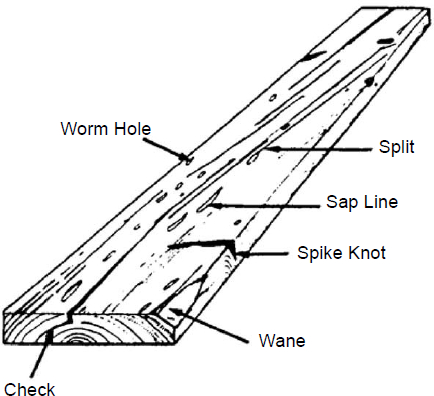

| Topic: Scaffold Planks | Issued by: VP WorkSafe Services |
| Statute: General Regulation 91-191 | Date Issued: December 4, 2008 |
| Section: Paragraph: 128(a) | Date Revised: |
128 An employer shall ensure that all wood used in a work platform is
(a) made of No. 1 grade or better spruce or fir.
Question
No. 1 grade or better spruce or fir scaffold planks are difficult to obtain. What else can be used?
Response
Historically, No. 1 grade planking specified in Regulation 91-191 was commercially available in New Brunswick. However, due to changes in grading rules, lumber is now typically graded as No. 2 grade and better. These changes followed a countrywide testing program that showed no significant differences in strength characteristics between No. 1 and No. 2 grades. The differences between grades relate primarily to the appearance of the material. Also, given that a number of Canadian timber species are grown, harvested, manufactured and marketed together, typical species combination for spruce and fir also includes pine. This species combination is stamped with the common designation S-P-F (spruce, pine, fir).
Therefore, No. 2 grade and better S-P-F lumber can be considered as equivalent to No. 1 grade and better spruce or fir. It should be noted that No. 2 grade lumber is more susceptible to water infiltration and incipient decay. Incipient decay in scaffold planking is a concern because it is hard to detect and has a dramatic effect on the impact resistance of the plank. A weight loss of 2-3% due to incipient decay can reduce the impact resistance on planks by as much as 50%. It is therefore important that every employer ensures wood used in a work platform is of minimum risk to health and safety when used as directed. Employers shall ensure the proper selection, inspection and maintenance of wood scaffold planks.
An important safety aspect that is often neglected on a formal basis is the inspection of scaffold planks. Planks often deteriorate quickly with use and age and are subject to damage. Don’t rely on others to inspect your scaffold planks or guarantee your safety and that of your co-workers. Insist that a trained individual from your firm does the inspection. At minimum, one should look for common defects as described and illustrated in the diagram on the next page.

PLANK DEFECTS
Planks can also be weakened by a condition known as dry rot. This condition is not easily recognized in its early stages, especially if the exterior of the planks has been weathered. However, planks that are substantially infected are usually lighter than sound planks of similar size and species. For this reason, planks that appear to be lighter than normal should not be used.
In addition to No. 2 grade and better S-P-F, the following are acceptable equivalents to the requirement of paragraph 128(a):
Manufactured platforms that are used in accordance with the manufacturer’s instructions and meet the following criteria:
Note: Manufactured platforms may not be required to meet the requirements of the following paragraphs of section 132 which state:
132 An employer shall ensure that a wood plank in a scaffold
(a) is at least 50 mm thick by 250 mm wide,
(b) has a span not longer than 3 m,
(c) extends at least 150 mm and not more than 300 mm beyond a supporting member, and
(d) is laid flat with an overlap of 300 mm with another plank, with the centre of the overlap directly over a bearer.
Manufactured planks that are used in accordance with the manufacturer’s instructions and meet the following requirements:
Built-up platforms constructed of No. 2 grade and better S-P-F grade two-by-four on edge, covered with 3⁄4” plywood. The plywood must:
Platforms designed by an engineer that meet the criteria in paragraph 1 and planks designed by an engineer that meets the requirements of paragraph 2.